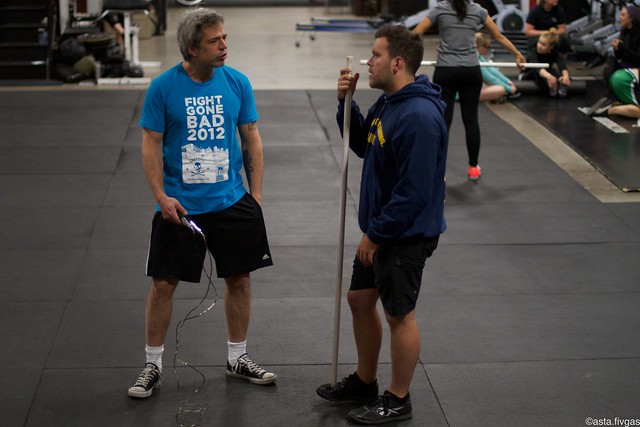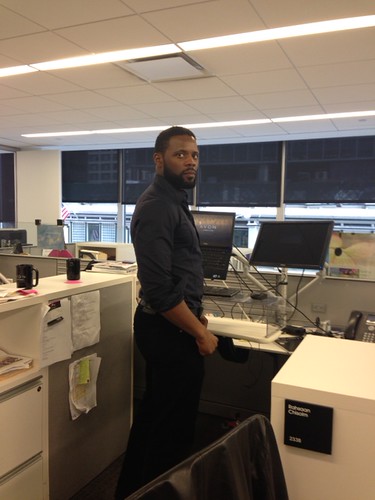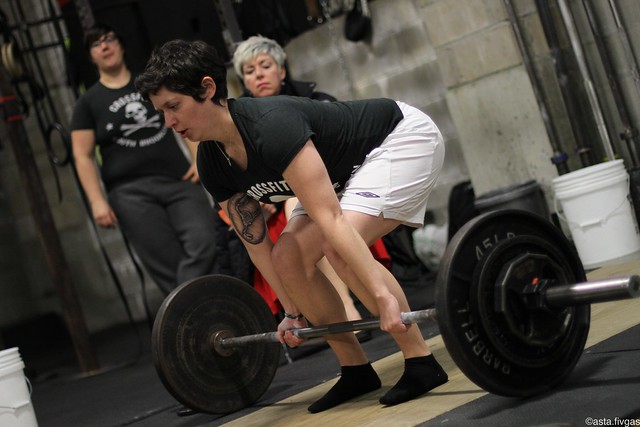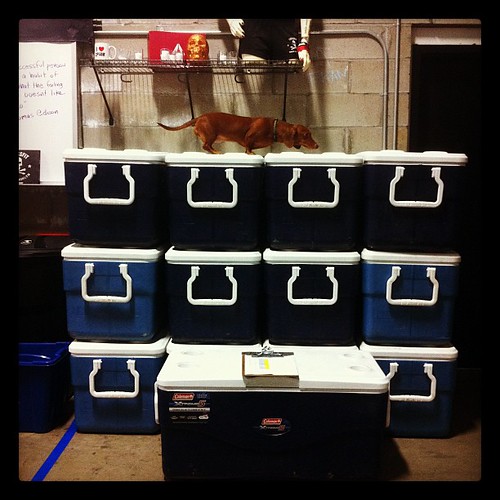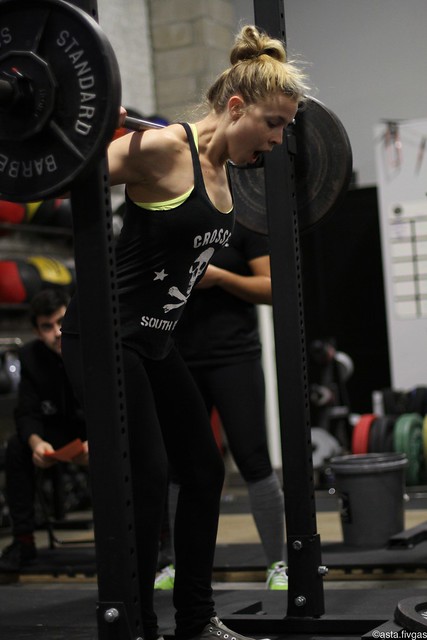How To Listen To Pain
By Dr. Jason Fidler
Unfortunately, most of us have been there. The sharp pain that shoots across your shoulders during your last set of sumo deadlift high pulls; the radiating pain down your thigh after heavy squats; the low back ache that lasts longer than normal after deadlifts. No matter how properly you train, pain is inevitable.
During my 5 years at CrossFit gyms, members have often approached me once they learn I am a chiropractor. They frequently ask me for a quick assessment or an easy answer to a nagging injury and, like many of us, they may not have the time for a proper assessment, which would include a detailed history, orthopedic testing and a treatment plan to figure out the true cause of their issue(s). What I have learned from such interactions is the importance of listening to pain, specifically, the questions that it poses.
What is pain? When should one power through a workout versus stopping? How should one respond to what the body is saying and what needs to be involved in this thought process? How do we define exacerbating and alleviating factors and when is it time to consult a professional? Understanding these questions will not only help you to develop a better body awareness but will also help you to avoid injury and better communicate when speaking with a doctor/therapist/trainer.
What is pain?
Remember the phrase “no pain, no gain”? It is antiquated and dangerous when applied to the type of WODs (workouts of the day) crossfitters endure. Pain is there for a reason. It is the body’s way of telling you that something is being compromised biomechanically or that you are actually aggravating an existing injury.
There are many different types of pain and all athletes endure some form of it. We will be focusing on a certain kind of pain, however. We’re not talking about the delayed onset muscle soreness (DOMS) that you get over the days following an intense workout. That is actually a good pain. That signals those tissues were fatigued and are now rebuilding to become bigger and stronger. It’s a sign that your body is adapting. More on DOMS later. We’re talking about the type of pain that comes from a soft tissue injury (sprain/strain/contusion), hard tissue injury (bone), and dislocation or overuse injury. It is important to consider whether these sensations have been caused by an acute, repetitive or cumulative trauma so we can figure out the best way to fix them. In other words, recognizing if these injuries were caused by a macrotrauma or have accumulated from microtraumas, which would include poor flexibility, posture, muscular imbalances and your body’s compensations to your old injuries as well as activities of daily living (ADLs). This is called “pathological” pain.
Chapman and Stillman (1996) defined pathological pain as “severe persisting pain or moderate pain of long duration that disrupts sleep and normal living, ceases to serve a protective function, and instead degrades health and functional capability.”
(Chapman CR)
Thought Process and Journaling
Whether I’m treating patients in the office or training hard in the gym, I’ve learned that the body gives us a variety of messages. To ignore them is to set yourself up for failure. The intense burn that we feel as we power through a MetCon (metabolic conditioning session) is a very different feeling from the sharp pain in the knee, shoulder or low back that causes us to compensate with altered mechanics. This needs to be interpreted as the alarm bell.
Of course, you don’t need a medical degree to manage your health. The trick is knowing when to seek professional advice and when to make a change on your own.
The purpose of tuning in to your body is to rule out the following:
Soft tissue injury (sprain/strain/contusion)
Hard tissue injury (bone)
Dislocation/fracture
Overuse injury
CrossFit Burnout (overtraining)
So what is the thought process in deciphering the different types of pain experienced?
Let’s say that you’re working out and all of a sudden you experience pain, discomfort or a “wonky” feeling.
It is helpful to record details in your workout journal. Doing so on a spreadsheet allows you to save it to the Cloud, and keyword search more easily for data, such as benchmarks or pain events.
Step 1 – Alert a coach
Step 2 – Define chief complaint (low back pain, shoulder pain) and how it happened, if possible
Step 3 – Describe provocative and alleviating factors (pain at low back with bending forward, lifting arm overhead alleviates pain in shoulder, etc.)
Quantify your level of discomfort by subjectively rating the severity on a 1-10 pain scale, 10 being the worst, or giving a percentage of how strong that region of your body feels.
Step 4 – has this happened before and is it getting worse?
Here are a few common injury situations with suggested action responses. They correspond to the flowchart attached to this article. Some may seem like obvious reactions, but, in the name of progress we often ignore our pain and sometimes make it worse by continuing past it.
SITUATION 1 Knowing when to quit and recognizing CrossFit Burnout
Maybe you’re feeling unenthusiastic about working out and/or noticing more than the usual soreness? This is what’s called “CrossFit burnout”. This status highly elevates risk for injury. Over-training means that you are exercising in excess of your body’s capacity to repair itself and adapt to the stresses you are presenting it with. Be mindful of CrossFit burnout. If you are overtraining, your body’s repair mechanisms are overloaded and you’re in prime position for injury.
In this situation, scaling back on intensity and weight or taking a few days to a week off would be the most appropriate response. Most likely you’ll feel reenergized after a few days off. If the complaint does not improve, however, then it’s time talk to a coach to reconsider your training program or to a health professional who is familiar with high intensity training.
Common but subtle signs of overtraining are:
- Losing strength
- Feeling tired at the gym
- Loss of motivation to work out
- Generally feeling burned out
- Contracting illnesses such as colds and the flu
SITUATION 2 A visible change in a joint or region of the body
Is the location of your pain showing discoloration, abrasion, scars, edema (swelling) or deformity* (DASED)? If so, stop training, alert a coach and proceed to rest, ice, compress and elevate (RICE). Try to clarify the qualities of the pain. These may include the following: aching, sore, cramping, pounding, sharp, throbbing, dull, nagging, penetrating, shooting, number, tingling, spasm, burning, radiating, stabbing, tender, knife-like, etc.
Is it getting better after a few days to a week of rest? If yes, then you may resume training at less than full intensity. If not, consult a professional.
If you are feeling even slightly symptomatic, then performance and intensity SHOULD NOT be your primary goal. But rather consistent movement patterns conducted with proper biomechanics.
When you are feeling asymptomatic (presenting with no symptoms), preventative maintenance is key. It is unfortunate that most people wait for a cavity to see the dentist or excruciating back pain to see the chiropractor. But we don’t wait for our car to break down to get an oil change. Think of your body as a high performance machine that requires routine maintenance to keep it running optimally. Proper alignment of your spine and the release of muscle adhesions you may or may not have been aware of will certainly make you less injury prone. In fact, it will most likely lead to performance enhancement. More on preventative maintenance and performance enhancement in a future article.
SITUATION 3 Nerve-y stuff
Are you experiencing pain or numbness that shoots into your arm(s) or leg(s)? If this is the case, then you are experiencing pathology to the nerve roots in the spine. You should definitely stop training and see a healthcare professional.
SITUATION 4 Dislocation or fracture
Are you unable to move a certain body part, such as a shoulder or ankle, and do you suspect dislocation or even a possible fracture? In this case, you will need to immediately immobilize that region with a splint or sling, RICE it and visit the ER where they can provide more advanced real-time diagnostics.
Sample Journal Entries
In both examples above, I’ve described location, provocative factors and sensation of my ailments, quantified the level of my discomfort and progress. While neither situation required discontinuing my workout, I recognized a pathological pain, gave it a concise description and made the appropriate modifications, which lead to an elimination of trauma to my toe.
Should you train with sore muscles?
It depends. Mild to moderate DOMS is normal and not likely to increase your risk of injury. On the other hand, if a particular region of the body experiences severe soreness it is advised that you allow it to rest and recover. For instance, if your low back is extremely sore after Grace (30 Clean and Jerks of 135lbs for time) then you may want to avoid working heavy deadlifts, a very similar movement, the next day. Pull-ups or running instead may be a less risky progression, as they are less taxing on already fatigued muscles.
Let’s say you have done a heavy 5-5-5 overhead press WOD. You can expect to feel some soreness/fatigue in the shoulder muscles later on in the week. If you notice excessive pain and soreness in or around the shoulder joint then this is a sign of pathological tissue damage and you need to refine your technique with less of a load. Again, this information needs to be recorded in your journal. Make a note of where you feel sore and share this information with a trainer to help you improve your technique.
Consulting a professional
Who is a professional? Your CrossFit coach can do a lot to help improve your performance, remove inefficiencies and make other helpful recommendations. However, it is outside of their scope to make a medical diagnosis. This falls within the scope of your sports chiropractor (DC), physical therapist, general practitioner (MD) or an orthopedist.
If you continue to feel tingling and numbness, pain that does not resemble DOMS or if discoloration and deformity has not subsided significantly within a week, then it is time to consult a professional.
Conclusion
You don’t always have to do what’s on the whiteboard, also know as the prescribed workout of the day. While healing from an injury, modifications can always be made. Do not hesitate to ask a coach to help you come up with alternative movements. My toe injury for instance, which became exacerbated by bending my toe upwards in reverse lunges, was modified by simply being prescribed forward lunges. I still made all of the same gains without any of the pathologic pain.
A word on over the counter anti-inflammatory medications. Pain is there for the purpose of preventing further injury and by artificially reducing it you run the risk of silencing this alarm. Also, there is no evidence that these medications help you to heal any faster.
Aches and pains should be accepted for what they are – useful feedback from your body telling you to give certain areas some rest. Everybody has different healing rates and you must learn to grasp yours.
Just like good listeners strengthen a relationship, hearing your body’s pain, and devising an appropriate response to it, will better equip you with enduring strength.
Chapman CR, Stillman M: Pathological Pain, Handbook of Perception: Pain and Touch. Edited by Krueger L. New York, Academic Press, 1996, pp 315 – 340
What Your Pain Is Telling You Flow Chart
click to enlarge
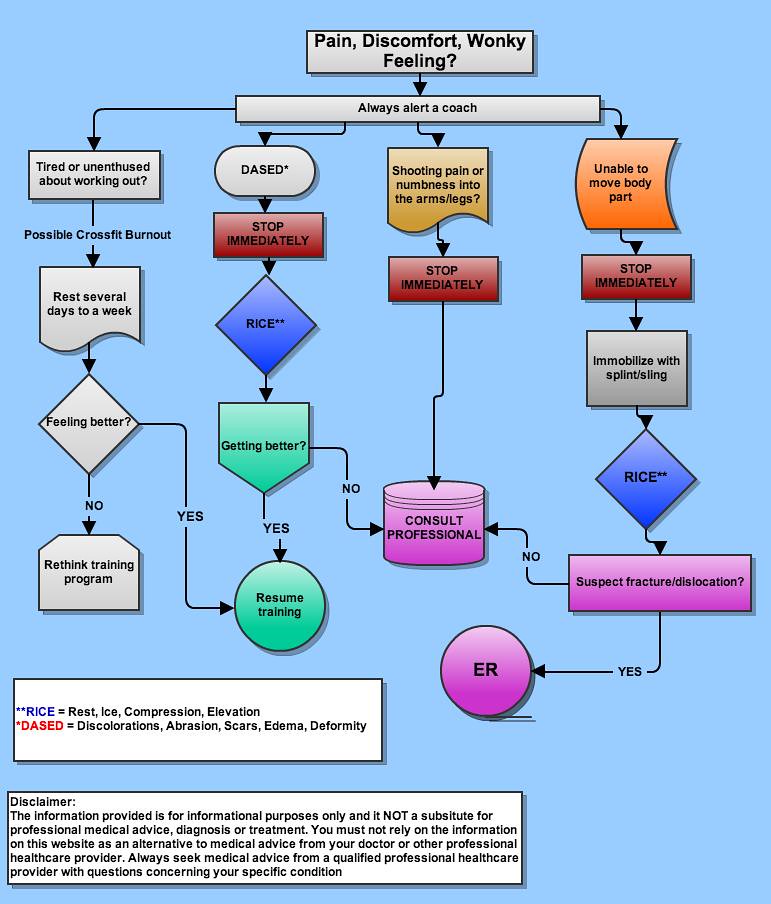
*Deformity means that the joint or region appears abnormally swollen, bent the wrong way or moving in obviously abnormal range of motion. This requires immediate attention.
Jason Fidler is a chiropractor serving the athletes and members of the CrossFit community in Brooklyn and lower Manhattan. He regularly trains and has office hours at CrossFit South Brooklyn and CrossFit 718. He is also a regular physician at many of the NYC endurance races and CrossFit competitions. As a CrossFitter and chiropractor since 2008, he is schooled in the functional movements that crossfitters routinely perform, their commonly associated training injuries and the most effective forms of treatment. Dr. Fidler holds full spine Active Release and Kinesio taping certifications, two very effective sought-after treatment protocols. To learn more, visit FidlerDC.com



